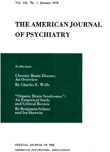PERSONNEL AWARENESS OF PATIENTS' SOCIALIZING CAPACITY
Abstract
Interviews of ward personnel and families of patients were conducted to determine the quantity and quality of patients' leisure-time pursuits; to determine the degree of personnel's awareness of these pursuits; and to determine the sources utilized by personnel for gaining information on the leisure-time activities prior to hospitalization. The findings were as follows:
1. Before illness, patients primarily selected leisure-time activities that required skill rather than passive watching. Most popular were activities of a routine, everyday nature pursued casually in groups. A few patients had more specialized skills and interests such as ballet, clothes designing, etc.
2. Personnel were aware of only 23.3% of patients' pre-illness leisure-time activities. There was high awareness on 3 patients, partial awareness on 8, and no awareness on 19. Although they were in agreement with family members as to patients' being doers rather than spectators (more active than passive pursuits), personnel saw patients as pursuing their leisure-time activities alone rather than in groups. They showed their highest awareness in the case of patients who had already begun to socialize.
3. Two main sources for gaining information regarding patients' prehospitalization activities were conversation with and observation of the patients on the ward. In only a few instances did they communicate with other personnel or with patients' families before the patients themselves made their interests known.
These findings have special relevance to the nurse's role as a socializing influence. It is clear that nurses are very often unaware of the socializing capacities of their patients. Without this information, the possibilities of bringing patients into social interaction remain limited, and many opportunities to help them emerge from their withdrawn state are missed. On the other hand, if fully informed of the patients' potentialities, the nurse may carry out more effectively her important function as a socializing leader.
Access content
To read the fulltext, please use one of the options below to sign in or purchase access.- Personal login
- Institutional Login
- Sign in via OpenAthens
- Register for access
-
Please login/register if you wish to pair your device and check access availability.
Not a subscriber?
PsychiatryOnline subscription options offer access to the DSM-5 library, books, journals, CME, and patient resources. This all-in-one virtual library provides psychiatrists and mental health professionals with key resources for diagnosis, treatment, research, and professional development.
Need more help? PsychiatryOnline Customer Service may be reached by emailing [email protected] or by calling 800-368-5777 (in the U.S.) or 703-907-7322 (outside the U.S.).



